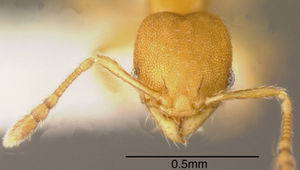Pheidole otisi
| Pheidole otisi | |
|---|---|

| |
| Scientific classification | |
| Kingdom: | Animalia |
| Phylum: | Arthropoda |
| Class: | Insecta |
| Order: | Hymenoptera |
| Family: | Formicidae |
| Subfamily: | Myrmicinae |
| Tribe: | Attini |
| Genus: | Pheidole |
| Species: | P. otisi |
| Binomial name | |
| Pheidole otisi Wilson, 2003 | |
According to Longino (1997), the species nests in pieces of dead wood in the ground litter of lowland wet forest, including beneath the bark of rotten logs. It forages on the ground and in low vegetation, and workers have been observed at extrafloral nectaries of Passiflora pittieri.
Identification
See the description in the nomenclature section.
Keys including this Species
Distribution
The Atlantic and Pacific lowlands of Costa Rica (Longino 1997).
Latitudinal Distribution Pattern
Latitudinal Range: 15.6864989° to 8.407045°.
| North Temperate |
North Subtropical |
Tropical | South Subtropical |
South Temperate |
- Source: AntMaps
Distribution based on Regional Taxon Lists
Neotropical Region: Costa Rica (type locality), Honduras.
Distribution based on AntMaps
Distribution based on AntWeb specimens
Check data from AntWeb
Countries Occupied
| Number of countries occupied by this species based on AntWiki Regional Taxon Lists. In general, fewer countries occupied indicates a narrower range, while more countries indicates a more widespread species. |

|
Estimated Abundance
| Relative abundance based on number of AntMaps records per species (this species within the purple bar). Fewer records (to the left) indicates a less abundant/encountered species while more records (to the right) indicates more abundant/encountered species. |

|
Biology
Castes
Worker
Minor
Images from AntWeb
  
| |
| Worker. Specimen code casent0635502. Photographer J. Longino, uploaded by University of Utah. | Owned by JTLC. |
Nomenclature
The following information is derived from Barry Bolton's Online Catalogue of the Ants of the World.
- otisi. Pheidole otisi Wilson, 2003: 481, figs. (s.w.) COSTA RICA.
Unless otherwise noted the text for the remainder of this section is reported from the publication that includes the original description.
Description
DIAGNOSIS A small, yellow species in the flavens group similar to Pheidole longinoi and Pheidole prolixa, distinguished in the major by a brown spot on the vertex of the yellow head; by the very low mesonotal convexity; stout, posteriorly directed propodeal spines; and absence of carinulae over most of the frontal lobes and entire middle half of the cephalic dorsum; and in the minor by the absence of a central convexity in the mesonotum, which drops steeply at the rear to the metanotal groove.
MEASUREMENTS (mm) Holotype major: HW 0.58, HL 0.66, SL 0.30, EL 0.08, PW 0.38. Paratype minor: HW 0.36, HL 0.38, SL 0.30, EL 0.06, PW 0.24.
COLOR Major: gaster and appendages clear light yellow, rest of body medium yellow, with a contrasting fuzzily defined brown spot 0.1 mm across in the middle of the head one-third forward from the occipital border.
Minor: concolorous medium yellow.
Figure. Upper: holotype, major. Lower: paratype, minor. Scale bars = 1 mm.
Type Material
COSTA RICA: La Selva Biological Station, near Puerto Viejo, Heredia, col. Stefan Cover and Mark Moffett. Museum of Comparative Zoology
Etymology
Acronymic, referring to the Organization of Tropical Studies, sponsoring organization of the La Selva Biological Station, site of the type collection.
References
- Wilson, E. O. 2003. Pheidole in the New World: A dominant, hyperdiverse ant genus. Harvard University Press, Cambridge, MA. (page 481, fig. major, minor described)
- Guerrero, R.J., García, E., Fernández, F. 2022. The Pheidole Westwood, 1839 ants (Formicidae: Myrmicinae) in Colombia: new records including two species with remarkable morphology. Zootaxa 5154 (3): 319-332 (doi:10.11646/zootaxa.5154.3.5).
References based on Global Ant Biodiversity Informatics
- Fernández, F. and S. Sendoya. 2004. Lista de las hormigas neotropicales. Biota Colombiana Volume 5, Number 1.
- Longino J. T. 2013. Ants of Nicargua. Consulted on 18 Jan 2013. https://sites.google.com/site/longinollama/reports/ants-of-nicaragua
- Longino J. T. L., and M. G. Branstetter. 2018. The truncated bell: an enigmatic but pervasive elevational diversity pattern in Middle American ants. Ecography 41: 1-12.
- Longino J. T., and R. K. Colwell. 2011. Density compensation, species composition, and richness of ants on a neotropical elevational gradient. Ecosphere 2(3): 16pp.

